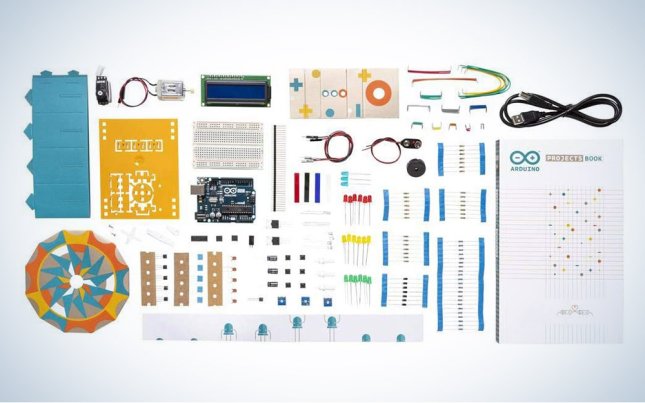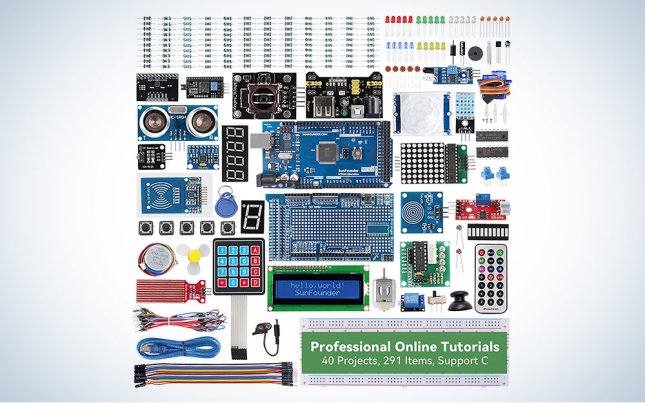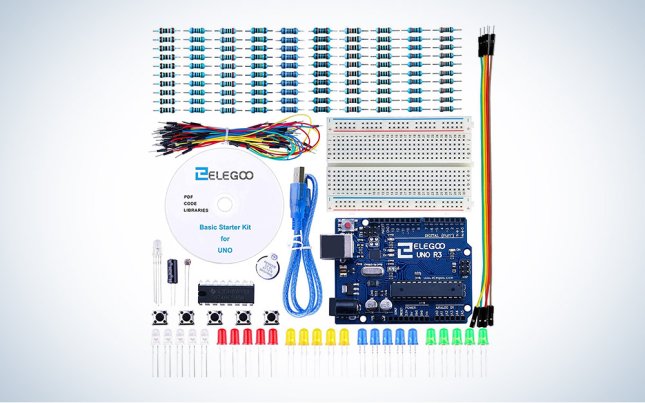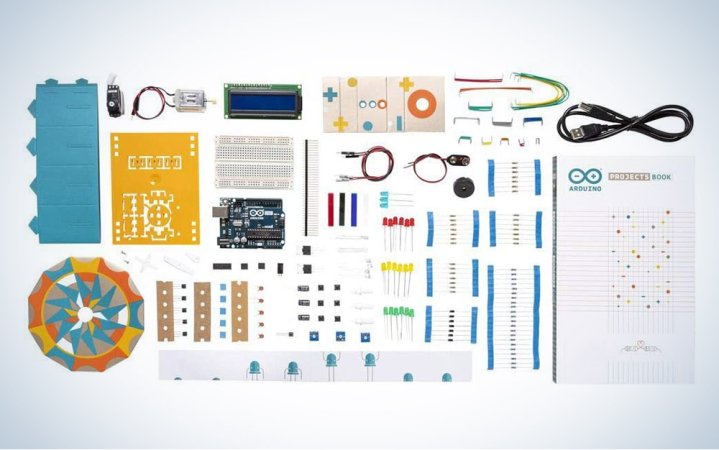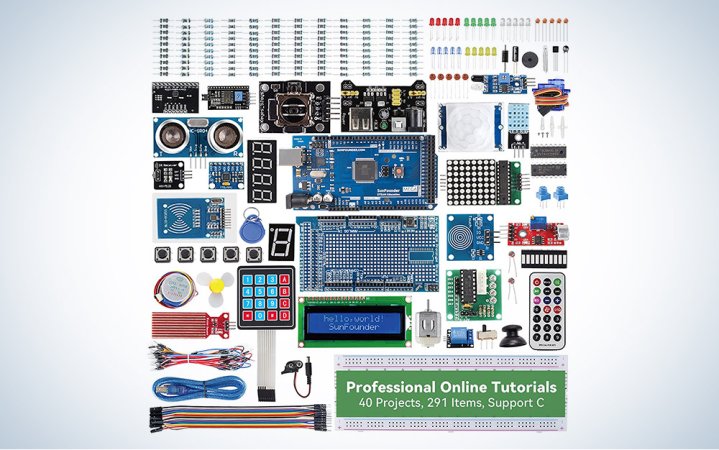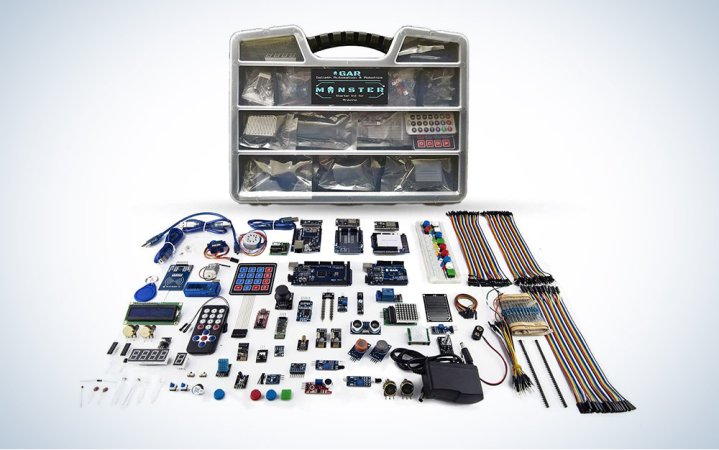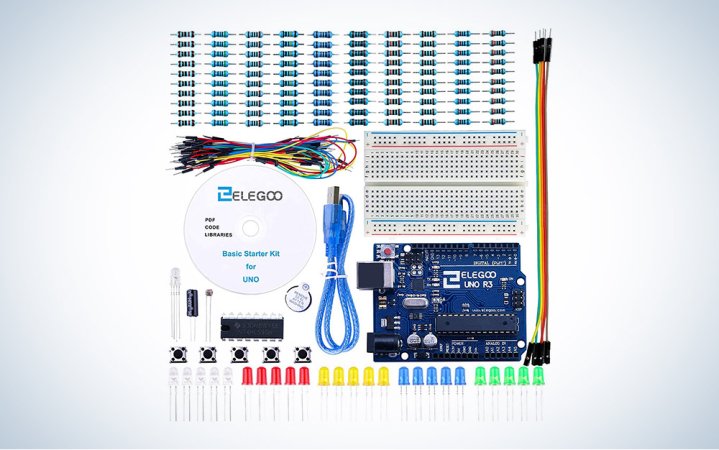We may earn revenue from the products available on this page and participate in affiliate programs. Learn more ›
Arduino kits are great for teaching students about science, technology, engineering, and math. The Interaction Design Institute in Turin, Italy, created Arduino in 2005 to provide people of all ages with an easy, inexpensive way to build electronic devices and control them with rudimentary code. By making Arduino an open-source platform, the Institute made the technology freely available to anyone, which led to a vast array of starter kits. Today, everyone from young children to seasoned professional techies uses them to build everything from simple devices that turn on the lights to robots controlled remotely via Wi-Fi. Given their popularity, there are a lot of kits available, like our best overall pick, the Official Arduino Starter Kit. We look at some of the best Arduino kits and break down what you’ll find and how to choose one suited to your project and learning goals.
- Best overall: Official Arduino Starter Kit
- Best upgrade: Sunfounder Mega2560 R3 Project Kit
- Best WiFi set: GAR Monster Starter Kit for Arduino
- Best budget: Elegoo UNO Project Basic Starter Kit
How we chose the best Arduino starter kits
Arduino kits have many similarities, so making our selection was not easy. Often, with our reviews, there are several key components to highlight, but Arduino starter kits have dozens, if not hundreds, of elements. In this case, it’s not a very practical approach. What we’ve done instead is ensure that a kit includes key elements, then focus on how each kit satisfies the needs of a particular learner. Does it suit a complete beginner? An intermediate user? Does it meet the criteria for STEM learning? By doing that, we believe we’ve provided a broad selection that offers something for just about everyone.
The best Arduino starter kits: Reviews & Recommendations
Most Arduino starter kits are very affordable and make for excellent STEM toys. That said, we included a premium option for those enthusiastic makers who want to develop multiple projects without having to shop for more components. Not surprisingly, larger kits also tend to offer greater versatility. No matter what you’re looking for, we’ve got an option here for you.
Best overall: Official Arduino Starter Kit
Pros
- High-quality components
- 170-page project book is easy to understand
- Many additional free resources available online
Cons
- Premium price
- Software must be downloaded
Why it made the cut: This kit, from the company that invented the Arduino system, teaches makers of all ages how software and hardware interact to produce real-world results.
Specs
- Board: UNO R3
- Number of Components: Over 100
- Projects Included: 15
Picking the best Arduino starter kit is no easy task, given the huge variety. That said, nobody has more expertise teaching beginners than the Arduino organization, and its official starter kit provides a wide-ranging yet easy-to-understand introduction to coding and electronics.
The Official Arduino Starter Kit is ideal for STEM learning or for adult hobbyists or professionals interested in these areas. It features the latest UNO R3 microcontroller board and more than 100 components. The array of switches, sensors, actuators, motors, and displays offers terrific versatility. The kit includes an excellent project guidebook. The Arduino software (called Integrated Development Environment, or IDE) isn’t supplied but is available as a free download.
Buyers pay a premium for the name, but the official Arduino starter kit is backed by an array of online resources that allow makers to expand their learning and undertake projects far beyond the 15 provided within this excellent kit.
Best upgrade: Sunfounder Mega2560 R3 Project Kit
Pros
- MEGA2560 board offers increased versatility
- Online tutorials extend capabilities
- Convenient storage case
Cons
- Not ideal for beginners
Why it made the cut: Budget Arduino starter kits are great for introducing beginners to coding and electronics, but eager learners soon want more. The SunFounder kit provides the logical ‘next step’ and great value for money.
Specs
- Board: MEGA2560 R3
- Number of Components: 291
- Projects Included: 40
Inexpensive entry-level Arduino kits are a great way to learn about coding and electronics. However, their versatility is somewhat limited, and those eager to continue learning may soon want more. Fortunately, they don’t need to spend much money to extend their skill set. This SunFounder kit offers an extensive collection of components and is of great value.
The kit is based on the MEGA2560 board, which is larger than the UNO and provides a wider range of connectivity options. That allows users to employ more complicated wiring. Used in conjunction with items like an ultrasonic ranging module, joystick, and tilt switch, makers can build more complex mechanisms. Although the kit includes 40 projects, many more can be developed using online resources.
Users must download the IDE separately. While SunFounder provides some code, it, like instructions, is not as comprehensive as it might be. It’s less detailed than some competitors’, meaning learners may have to find solutions elsewhere or use other online resources to maximize the kit’s potential. While these challenges are not difficult to overcome, we would not recommend this kit for beginners.
Best WiFi set: GAR Monster Starter Kit for Arduino
Pros
- One of the largest component collections available
- Includes three different microcontroller boards
- Wireless capabilities
Cons
- Expensive
- May be overwhelming for beginners
Why it made the cut: It’s expensive, but the GAR Monster starter kit can help beginners build and control complex wireless systems.
Specs
- Board: MEGA2560, UNO R3, NANO, ESP32 Wi-Fi & Bluetooth
- Number of Components: Over 500
- Projects Included: None (see description)
Goliath Automation and Robotics (GAR) claims its Monster starter kit for Arduino is second only to its $500 Colossus kit as the largest kit available.
While the Monster starter kit is not cheap, it is impressively comprehensive. Although it will appeal to more advanced users, it includes basics like the UNO R3 board that make it suitable for beginners. As a maker’s skills and knowledge increase, the MEGA2560 board allows them to pursue more complex projects, and the NANO and ESP32 platforms make it possible to develop wireless systems. The GAR Monster starter kit is also compatible with Windows, macOS, Linux, Android, and Raspberry Pi.
The instructions are fairly basic, and the main repository for projects is online. GAR offers an expanding library, but that’s just the start. Given the number and variety of components provided, those wishing to extend their knowledge will find hundreds of suitable projects online.
Best budget: Elegoo UNO Project Basic Starter Kit
Pros
- Remarkably low cost
- Good quality components
- IDE included on CD
Cons
- Breadboard (a plastic board used to prototype projects) is smaller than some expect
- Limited project scope
Why it made the cut: Elegoo makes a number of highly-rated Arduino starter kits. This one may be the most affordable one you’ll find, but it offers all the basics needed to get started.
Specs
- Board: UNO R3
- Number of Components: Over 100, though many are duplicates
- Projects Included: 8
The Elegoo UNO Basic Starter Kit is designed for those who want to try Arduino without spending much money. It includes the UNO R3 microcontroller, a reasonable assortment of components, and a CD that contains a PDF tutorial and the IDE software.
The tutorials focus on introducing the concepts of using code to drive electronic devices. It is a valuable introduction for beginners. The tutorials are very informative, and produce real-world results like illuminating an LED, activating a buzzer, and other fun projects). That said, keen learners will soon seek more demanding challenges, and although they’ll find other projects online, the variety of components included in this kit may limit their ability to pursue them.
The kit offers a couple hundred components, but many of them are duplicates. For example, it includes five red LEDs, five green LEDs, etc. Although it includes 130 resistors, they are limited to 10 types. Every component has its use in basic projects, but this kit does not offer the versatility that might appear at first glance.
What to consider when buying the best Arduino starter kits
Arduino is an open-source hardware and software platform, which means anyone can copy the designs to produce an Arduino starter kit. As a result, many are essentially clones of the original and are largely similar. That said, the quality and content of each kit can vary considerably. Here’s what to look for.
Boards
The core of every Arduino starter kit is a board that contains a microcontroller. This can interpret a signal (input) and perform an action (output) based on instructions supplied by the user. For example, pressing a button might turn on a light or move an object.
Arduino UNO, MEGA2560 and NANO are the most common boards, but many others are available. Each has its own specification, which will become of greater importance as a maker’s knowledge increases. Size may be a consideration if the goal is to build the board into, say, a robot or other confined space. UNO is the most basic and usually recommended for beginners. One of MEGA’s key features is the ability to accept more connections if the project’s wiring is complicated.
Projects and tutorials
Most Arduino starter kits come with a number of projects or tutorials. These may be contained within a booklet or a DVD containing a PDF. Quantity varies from a single tutorial to the 40 projects included in our best value suggestion.
The creative possibilities of a particular kit usually exceed what is covered by the tutorials, however. Manufacturer’s websites, and those run by Arduino enthusiasts, provide almost limitless expansion and variation. Video tutorials are common. Note however that if they are not specific to a particular kit, buying additional components may be necessary.
Components
There are literally thousands of Arduino components and modules available. It’s certainly an area worth exploring. For beginners, it is undoubtedly easiest to buy a starter kit and follow the tutorials provided. A ‘breadboard’ is a key component, allowing circuits to be built without soldering.
While many Arduino components are available individually, there is a compelling argument for buying additional starter kits, even for those people who have gained some experience. This is especially true if a maker has a particular project or range of projects in mind. Larger starter kits frequently contain parts for related projects, and buying one can often be easier than compiling an extensive shopping list. They are convenient and may offer better value. Compatibility issues aren’t common—all components should follow the Arduino standard—but buying from the same manufacturer ensures everything works together.
FAQs
The cost of an Arduino starter kit largely depends upon its complexity. The GAR Monster Starter Kit for Arduino, for example, which allows users to build wireless systems, has a list price of more than $225. But those looking to begin with a less expensive option can learn the fundamentals with the Elegoo UNO Project Basic Starter Kit.
It’s a difficult question to answer because all Arduino starter kits are essentially aimed at those with little or no prior knowledge. Our selections above offer a variety of solutions suitable for all learning levels and budgets.
It depends on the kit, though its contents usually give some idea. Once you understand the basics, you can build movement sensors, smoke or fire alarms, timers, air quality sensors, lighting controls, and basic robots. Every kit includes tutorials, but many others are available online. Once you’ve gained a little experience, you can also develop your own variations and share them with other Arduino engineers.
In basic terms, Arduino is designed for real-world building of models and prototypes, using simple coding for control. It teaches the interaction between software and hardware. A Raspberry Pi is a mini-computer for learning programming and software development. It can be extended to activate hardware, but that’s not its primary purpose.
Final thoughts on the best Arduino starter kits
- Best overall: Official Arduino Starter Kit
- Best upgrade: Sunfounder Mega2560 R3 Project Kit
- Best WiFi set: GAR Monster Starter Kit for Arduino
- Best budget: Elegoo UNO Project Basic Starter Kit
We can’t think of a better place to start the Arduino adventure than with the official Arduino starter kit. It provides a number of excellent examples of how software and electronics have real-world impact. However, it does come at a premium price. The Elegoo Uno is an Arduino starter kit for those who want to test the waters at minimal cost. Nevertheless, it has sufficient content to prove absorbing and deliver satisfying results.
